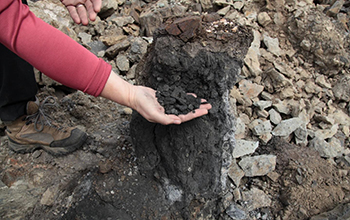搜索结果: 1-13 共查到“理学 Siberia”相关记录13条 . 查询时间(0.05 秒)

Volcanic coal-burning in Siberia led to climate change 252 million years ago(图)
Volcanic coal-burning Siberia led climate change 252 million years ago
2020/6/18
A team of researchers led by Arizona State University geoscientist Linda Elkins-Tanton has provided the first direct evidence that extensive coal burning in Siberia was a cause of the Permo-...
Freeze/thaw processes in complex permafrost landscapes of northern Siberia simulated using the TEM ecosystem model: impact of thermokarst ponds and lakes
Freeze/thaw processes complex permafrost landscapes northern Siberia simulated TEM ecosystem model thermokarst ponds and lakes
2014/12/19
Freeze/thaw (F/T) processes can be quite different under the various land surface types found in the complex tundra of the Arctic, such as polygonal tundra (wet center and dry rims), ponds, and thermo...
History of the Pollution in Tomsk Region (Siberia, Russia) According to the Study of High-Moor Peat Formations
Atmosphere Pollution High-Moor Peat Trace Elements in Peat
2011/11/30
A method that could be used to detect the change of the environment was used to determine the input of trace elements from the atmospheric fallouts into the biosphere near Tomsk city (West Siberia, Ru...
Source-receptor relationships for airborne measurements of CO2, CO and O3 above Siberia: a cluster-based approach
Source-receptor relationships airborne measurements Siberia
2010/2/15
We analysed results of three intensive aircraft campaigns above Siberia (April and September 2006, August 2007) with a total of ~70 h of continuous CO2, CO and O3 measurements. The flight route consis...
Late Glacial and Holocene changes in vegetation cover and climate in southern Siberia derived from a 15 kyr long pollen record from Lake Kotokel
Late Glacial vegetation cover Holocene changes
2009/12/3
In this study a radiocarbon-dated pollen record from Lake Kotokel (52°47´ N, 108°07´ E, 458 m a.s.l.) located in southern Siberia east of Lake Baikal was used to derive quantitative ch...
Late Glacial to Holocene environments in the present-day coldest region of the Northern Hemisphere inferred from a pollen record of Lake Billyakh, Verkhoyansk Mts, NE Siberia
Holocene environments Northern Hemisphere coldest region
2009/12/3
In this study, a radiocarbon-dated pollen record from Lake Billyakh (65°17' N, 126°47' E; 340 m a.s.l.) in the Verkhoyansk Mountains was used to reconstruct vegetation and climate change since about 1...
Lower and Middle Jurassic foraminiferal and ostracod biostratigraphy of the eastern Barents Sea and correlation with northern Siberia
Jurassic foraminiferal ostracod biostratigraphy eastern Barents Sea northern Siberia
2009/12/2
The Barents Sea shelf and adjacent areas comprise one of the important petroleum-bearing provinces of the world. During the last three decades,these areas have received considerable interest in the ex...
Methodology and calibration for continuous measurements of biogeochemical trace gas and O2 concentrations from a 300-m tall tower in central Siberia
Methodology calibration continuous measurements biogeochemical trace gas O2 concentrations
2009/5/26
We present an integrated system for measuring atmospheric concentrations of CO2, O2, CH4, CO, and N2O in central Siberia. Our project aims to demonstrate the feasibility of establishing long-term, con...
Temperatures and precipitation totals over the Russian Far East and Eastern Siberia:long-term variability and its links to teleconnection indices
monthly precipitation mean monthly temperature
2009/5/13
The present study examines the spatial-temporal regime of the mean monthly temperature (MMT) and monthly precipitation (MPT) anomalies over the Russian Far East and Eastern Siberia for the period 1949...
The growing season greenhouse gas balance of a continental tundra site in the Indigirka lowlands,NE Siberia
season greenhouse gas balance continental tundra site Indigirka lowlands
2007/11/14
Carbon dioxide and methane fluxes were measured at a tundra site near Chokurdakh, in the lowlands of the Indigirka river in north-east Siberia. This site is one of the few stations on Russian tundra a...
The exchange of carbon dioxide between wet arctic tundra and the atmosphere at the Lena River Delta,Northern Siberia
exchange carbon dioxide wet arctic tundra atmosphere Lena River Delta
2007/10/18
The exchange fluxes of carbon dioxide between wet arctic polygonal tundra and the atmosphere were investigated by the micrometeorological eddy covariance method. The investigation site was situated in...
Carbon balance assessment of a natural steppe of southern Siberia by multiple constraint approach
Carbon balance assessment natural steppe southern Siberia multiple constraint approach
2007/8/2
Steppe ecosystems represent an interesting case in which the assessment of carbon balance may be performed through a cross validation of the eddy covariance measurements against ecological inventory e...
Quantitative and qualitative relationships between planktonic diatom communities and diatom assemblages in sedimenting material and surface sediments in Lake Baikal, Siberia
Quantitative qualitative relationships Lake Baikal Siberia
2003/5/21
Endemic planktonic diatoms are a major component of Lake Baikal sediments during interglacial periods. To
investigate how these diatom assemblages are altered during sediment formation, quantitative ...

